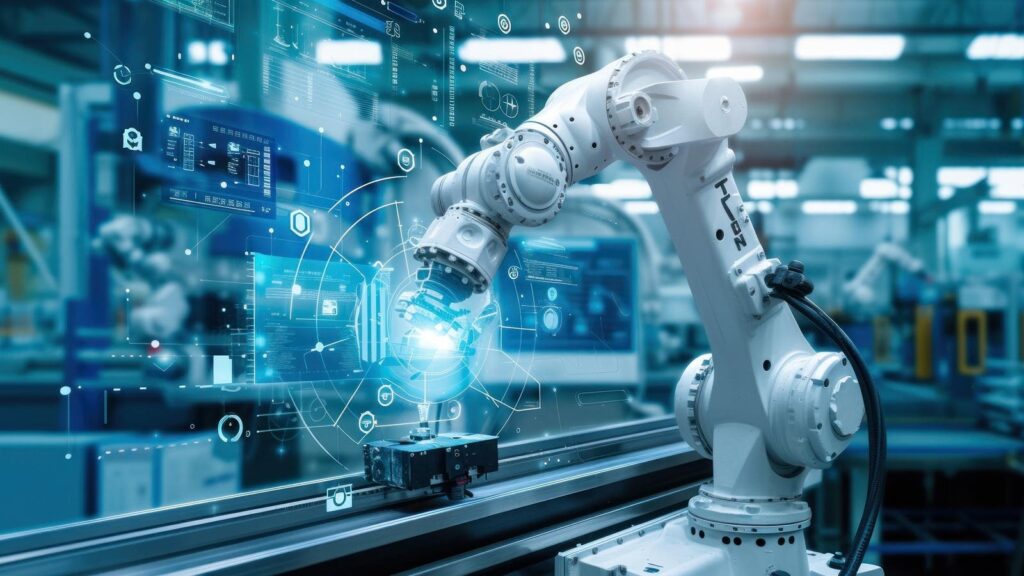Learn how generative AI, intelligent robots, and an AI-driven culture are transforming manufacturing. … (+)
The manufacturing sector is no stranger to innovation. In fact, it has always been at the forefront of digital transformation, taking in its stride the arrival of robotics, the Internet and new developments in materials science.
However, in 2025, the industry is still bracing for disruption as manufacturers around the world grapple with the implications of artificial intelligence. It is also increasingly important to improve sustainability as the climate crisis worsens and to build resilience in the face of political and societal uncertainty.
To meet these challenges, the companies responsible for creating the products we use every day are enthusiastically investing in disruptive technologies and adapting to cultural changes, such as the need to rethink skills and training.
So let’s see how this plays out over the next year by reviewing the key trends and opportunities:
Generative AI: reinventing manufacturing and design
In 2025, we will see manufacturers deploy many generative AI use cases designed to accelerate and improve the efficiency of manufacturing processes. By leveraging the power of generative design, it will be possible to create stronger, lighter components that make more efficient use of available materials. We have already seen aerospace companies leverage genAI to create new airplane partsand car manufacturers use it to optimize vehicle design. I believe we will see many more innovative use cases in the coming year as manufacturers increasingly integrate genAI into their operations.
Smarter robots
Robots are not new to manufacturing; in fact, robots have been working in factories for over 50 years. What is new, however, is the next generation of intelligent robots that can work safely and efficiently alongside humans, apply themselves to different tasks and learn to become more efficient in their work and in their environment. As robots move away from the assembly line and in the labor markethumans will develop new skills to lead and interact with automated colleagues – sometimes called “cobots”.
Leadership in the AI Age
Position a company as a leader rather than just a follower or even a laggard in the AI era, will become a growing priority for many manufacturing companies. Simply put, it is no longer enough to adopt new technologies like robotics, predictive maintenance and automation. As barriers to entry continue to fall, there is a need to act in a way that is more innovative, more effective and efficient than the competition. Developing the ability to not only follow trends, but also identify opportunities to lead the way will become increasingly a priority in 2025.
Sustainability in manufacturing
There are many reasons why sustainability is quickly becoming a business priority for manufacturers in 2025. Among them, consumer demand, stricter regulations and the simple fact that we are increasingly seeing the impact of climate change in the world around us. For this reason, we can expect to see a strategic shift towards cleaner and greener operations, such as the use of renewable energy, recyclable materials, reduction of emissions, excessive packaging and consumption of water.
Building the manufacturing workforce of tomorrow
There is a widely recognized skills crisis among sectors hoping to take advantage of the opportunities offered by AI, robotics, advanced data analytics and automation. To close this skills gap, manufacturers will need to rethink how they hire and train their staff, and for many this will become a key business priority in 2025. Meeting this challenge may involve investing in upskilling and reskilling, to develop apprenticeship programs or establish new relationships with companies. educators and academics.
Dark Factories
This year, smartphone manufacturer Xiaomi lit its fully autonomous dark factory near Beijing, capable of producing 10 million phones a year without human intervention. This model will become increasingly common as manufacturers seek improved efficiency, sustainability and reduced waste. While “dark” factories have been around for a while, Xiaomi’s factory is the first to be able to learn how to operate more efficiently and optimize its own processes thanks to its AI-powered “brain”.
Adopt and adapt to the “AI First” culture
There can undoubtedly be cultural barriers to AI adoption. Some people worry that it will replace them or make them redundant, while others believe that decision-making should not be left to machines. While these concerns are all valid, identifying areas where AI can clearly solve problems or create efficiencies while mitigating its potential for harm will be a priority for the manufacturing industry in 2025. This will involve planning and implementing initiatives. promote understanding of AI in the workforce and ensure its benefits are felt by all.
Smart supply chains
The logistical challenges of sourcing components and managing complex inventory and production infrastructure are ideally suited to automated and intelligent solutions. AI-based tools leveraging real-time data analysis will enable more accurate demand forecasting and automated decision-making, helping manufacturers build more resilient supply chains that are more adaptive to changing market conditions. walk. By 2025, AI will enable manufacturers to more effectively anticipate disruptions and identify opportunities to improve efficiency, ultimately leading to better customer experiences and business performance.
By 2025, the manufacturing sector finds itself at a pivotal moment in its transformation. While challenges around AI adoption, sustainability, and workforce development remain significant, the convergence of smart technologies, automated systems, and sustainable practices creates opportunities for innovation without previous. Companies that successfully navigate these changes – by embracing AI-driven efficiency while creating resilient, sustainable operations and investing in their workforce – will be best positioned to thrive in the next era of technology. manufacturing industry. The future of manufacturing is not just about automation and AI: it is also about creating smarter, more sustainable and more adaptive production systems that can meet the challenges of tomorrow.


